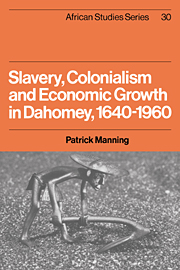Book contents
- Frontmatter
- Contents
- Maps
- Tables
- Figures
- Preface
- 1 Slavery, colonialism and economic growth, 1640–1960
- 2 The Dahomean economy, 1640–1890
- 3 Struggles with the gods: economic life in the 1880s
- 4 Production, 1890–1914
- 5 Demand, 1890–1914
- 6 Exchange, 1890–1914
- 7 The alien state, 1890–1914
- 8 Social struggles for economic ends, 1890–1914
- 9 The mechanism of accumulation
- 10 Capitalism and colonialism, 1915–60
- 11 The Dahomean national movement
- 12 Epilogue
- Notes
- Appendix 1 Export revenue from Dahomey, 1640s–1950s
- Appendix 2 Slave exports by ethnic origin
- Appendix 3 Population loss due to slave exports
- Appendix 4 Foreign trade of Dahomey
- Appendix 5 Foreign trade indices
- Appendix 6 Rainfall
- Appendix 7 Fiscal flows
- Appendix 8 Money supply of colonial Dahomey
- Bibliography
- Index
- Frontmatter
- Contents
- Maps
- Tables
- Figures
- Preface
- 1 Slavery, colonialism and economic growth, 1640–1960
- 2 The Dahomean economy, 1640–1890
- 3 Struggles with the gods: economic life in the 1880s
- 4 Production, 1890–1914
- 5 Demand, 1890–1914
- 6 Exchange, 1890–1914
- 7 The alien state, 1890–1914
- 8 Social struggles for economic ends, 1890–1914
- 9 The mechanism of accumulation
- 10 Capitalism and colonialism, 1915–60
- 11 The Dahomean national movement
- 12 Epilogue
- Notes
- Appendix 1 Export revenue from Dahomey, 1640s–1950s
- Appendix 2 Slave exports by ethnic origin
- Appendix 3 Population loss due to slave exports
- Appendix 4 Foreign trade of Dahomey
- Appendix 5 Foreign trade indices
- Appendix 6 Rainfall
- Appendix 7 Fiscal flows
- Appendix 8 Money supply of colonial Dahomey
- Bibliography
- Index
Summary
This is a study of long-term and short-term economic change in a West African region, based on analysis of foreign trade statistics, colonial finances, and descriptions of the domestic economy. Of the many economic conflicts considered in this survey, two stand out: the export of roughly two million slaves in the years 1640–1865, which depopulated the region for part of that time, and the export of tax revenues by the French government in the years 1905–60, averaging over twenty percent of the value of exports each year. Nevertheless, despite such negative external influences, the economy grew over this three-century period. The apparent contradiction between negative external influences and positive domestic growth is resolved through the elucidation of a mechanism of accumulation: based on a detailed analysis, for the years 1890–1914, of short-run economic dynamics and the economic significance of social, political and legal disputes, I attribute the distillation of long-run growth out of short-run activities to specific causes, of which population growth and producer investments were most fundamental. The analytical framework of the mechanism of accumulation and the modes of production through which it operated provided the structure for my analysis of long-run economic change.
The study is centered on Dahomey, as I will call the southern portion of the modern People's Republic of Benin, a rectangle of one hundred kilometers from east to west and two hundred kilometers from north to south, which includes the eastern Aja–Ewe peoples and the most westerly Yoruba peoples.
- Type
- Chapter
- Information
- Slavery, Colonialism and Economic Growth in Dahomey, 1640–1960 , pp. xiii - xviiiPublisher: Cambridge University PressPrint publication year: 1982

